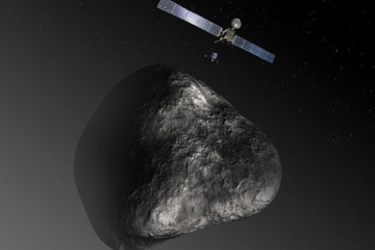Philae Lander Sends First-Ever Images From A Comet
By Chuck Seegert, Ph.D.

The Philae lander, the first human spacecraft to ever land on a comet, has sent back initial images from the surface. After a touch-and-go landing, the probe settled on the surface of the comet that it has been chasing since 2004.
The Rosetta mission is a European Space Agency (ESA) project designed to have the Philae lander touch down on the comet 67P/Churyumov–Gerasimenko and collect a myriad of information. Other probes have been sent to comets before — like NASA’s Ice mission that flew through the tail of Halley’s comet in 1986 and the Deep Impact mission that fired a massive copper block at the Temple 1 comet in 2005. Never before, however, has a human spacecraft landed on a comet, according to a recent story from The Guardian.
The Philae lander experienced some initial difficulties on the comet when a harpoon device designed to anchor the probe to the comet’s surface failed to deploy, according to The Guardian. This led to the lander literally bouncing on the surface twice before it finally settled on its third touchdown.
The first images from Philae showed the craggy surface of the comet and one of its legs. The images collected by the Comet Infrared and Visible Analyzer (CIVA) were expected to take a panoramic view of the comet and the area surrounding the landing zone. The images received, however, had scientists speculating that the lander had settled into a ditch or surface feature that didn’t allow a full view, according to The Guardian.
“We are definitely not in the open,” said Fred Jansen, ESA Rosetta mission manager, in The Guardian story.
The CIVA-P system, which was designed to produce the panoramic imagery of the comet, is composed of seven identical cameras that are designed to analyze the surface topography and the reflectivity of the area surrounding the landing zone, according to the CIVA website. The CIVA payload consists of a second set of instruments called the CIVA-M, which was designed to microscopically examine samples delivered by the sample drilling and distribution system (SD2).
Comets are thought to be composed of materials that are older than our solar system, according to The Guardian. This unique opportunity, which cost about $1.5 billion, allows researchers to garner clues about how the universe formed and how comets carry water and organic molecules. As comets approach the sun, they often send up plumes of water and other volatile substances that form a tail. This promises to be an interesting time, as the data gathered by the Philae lander will give insight into this process.
The Philae lander has been traveling with the Rosetta mothership for over 10 years to date. Recently, the lander separated from the Rosetta and took images of itself as it prepared to touch down on the comet, according to a recent article from Photonics Online.
Image Credit: ESA–C. Carreau/ATG medialab
